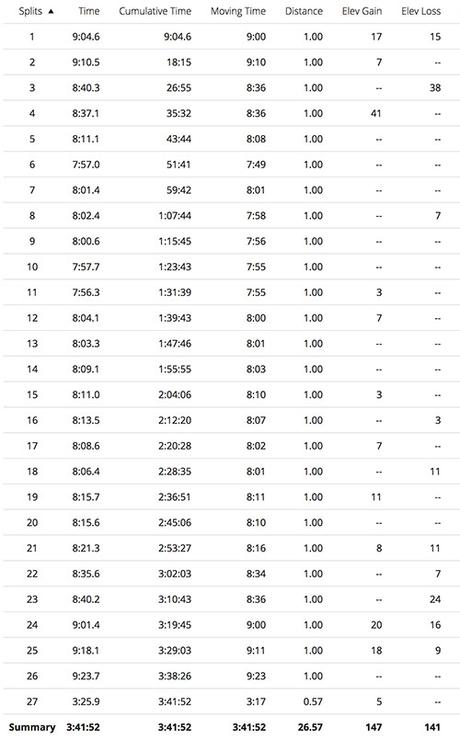There are two noble things in life: one to do charity and other to look after your body.
– Fauja Singh, i.e. the “Turbaned Tornado” and the only centenarian to run a marathon
(Happy birthday, Mom! What proud mother doesn’t want a 7,000-word blog post for her birthday?)
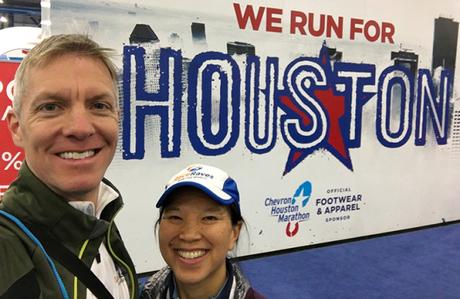
As the bumper sticker tells it, “I wasn’t born in Texas, but I got here as fast as I could.” California may be my birth place and current home, but I grew up in Texas. Almost all of my first 23 years were spent in the Lone Star State, including 14 in the suburbs of Dallas and another four as an undergrad at Rice University in Houston.
I’ve been told (with a wink and a smile) I’m a terrible Texan, and I can’t disagree — I’ve never owned a pair of boots, have no discernible accent (Mom is from Colorado, Dad was from Boston) and am a liberal, BBQ-averse vegetarian. So you might think Texas and I have our irreconcilable differences. But in the case of me and my home state, opposites really do attract… or maybe it’s more like a case of Stockholm Syndrome? In any case, I have a curious but unshakeable affinity for the state that gave the world Crazy Rick Perry and “Lyin’ Ted” Cruz — though certainly not the same affinity I have for California.
In fact, noted Californian John Steinbeck may have best summarized what it means to be a Texan, saying, “I have said that Texas is a state of mind, but I think it is more than that. It is a mystique closely approximating a religion…. Texas is the obsession, the proper study, and the passionate possession of all Texans.”
I recognize, too, that much of this nostalgia for my home state stems from my four years spent at Rice, a nerdy blue oasis of letters and science in an otherwise red desert of football fanaticism.
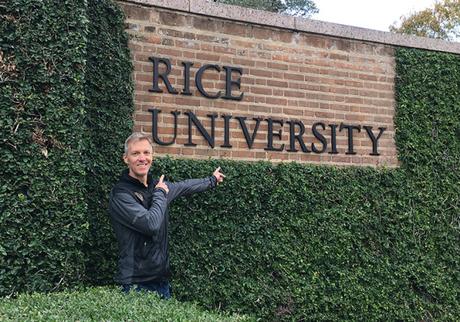
Growing up a basketball player, I didn’t transition from team sports until I reached the West Coast — I had run some shorter races in Texas, but never anything longer than a half marathon. So when I embarked on my current quest to run a marathon (or longer) in all 50 states, my home state was understandably high on my “looking forward to” list. I knew I wanted to do something different, something special to celebrate my homecoming and set it apart from the other 49 states. Something worthy of the popular refrain that “Everything’s bigger in Texas.” But what that was, I had no idea.
Then came Hurricane Harvey. And in the blink of an eye, that popular refrain mutated from tongue-in-cheek promise to nightmarish reality.
Over the course of several days in August, Harvey dropped over 60 inches (roughly 20 trillion gallons) of rain on Southeast Texas, causing catastrophic flooding, 104 confirmed deaths and a reported $125 billion in damage. All of which made it the single largest rainstorm and one of the costliest natural disasters in US history, with a monetary toll comparable to Hurricane Katrina.
The totals are too mind-boggling for most of us to wrap our heads around. By comparison, it takes more than four years for my hometown of Los Angeles to accumulate that much rain. Watching the news coverage in helpless disbelief as scene after scene of watery devastation played out across Houston, I realized my best chance to help the city I’d called home for four years was by running — not away from the problem, but toward it.
With large swaths of the Bayou City underwater and less than 20% of homeowners having flood insurance, it quickly became apparent that once the camera crews departed and the daily coverage subsided, the hard work of getting the nation’s fourth-largest city back on its feet would begin. And for many, the fight to pick up the pieces left behind by Harvey would be the uphill battle of their lives.
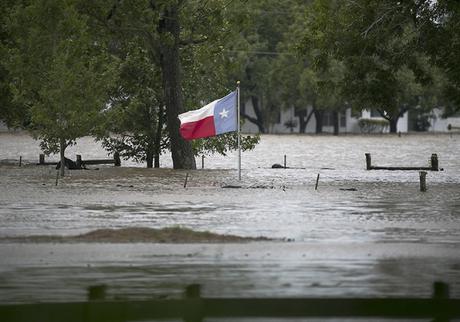
(photo: Ralph Barrera / Austin American-Statesman)
Running for a Reason
With the Houston Marathon scheduled for mid-January, the timing was ideal for me to plan and execute my own version of the Texas two-step: running and recovery. So in September I made the decision to run marathon #30 in state #19 while raising funds for Hurricane Harvey relief. And the organization I chose to support was the Houston Food Bank.
With 64 potential charity partners in the Houston Marathon’s “Run for a Reason” program, why the Food Bank? Honestly, the choice was easy. One reality I can’t wrap my head around is the fact that in America in the year 2018, there are still many individuals who don’t know where their next meal is coming from. No citizen of the wealthiest nation on the planet should ever face food insecurity, and yet 1 in 8 do. Katie and I have volunteered at food banks in California and appreciate the excellent work they do with scarce resources. So when I decided to support the hurricane relief efforts, the Houston Food Bank appealed to me as a top-rated charity that addresses a dire need and does it with unrivaled efficiency, given that every dollar donated provides a full day of meals for a child, adult or senior.
What’s more, I knew running for the Food Bank would help fuel my fundraising efforts. Because anyone who’s tried can tell you: fundraising is hard. No one ever likes to reach out to friends and family to ask for money. But when you’re all in and deeply committed to the cause, that commitment makes all the difference. And ensuring people have enough to eat — plus the dignity that comes with food security — is a cause I’m proud to get behind.
At the same time, I wasn’t naïve. Harvey may have been the worst hurricane of 2017 in terms of its financial toll, but it certainly wasn’t the only one. Irma and Maria followed in rapid succession, slamming into Florida and the Caribbean and, in the case of Maria, marking the worst natural disaster in Puerto Rico’s history. Add to that the devastating wildfires in Northern and Southern California as well as drought, hailstorms, tornadoes and other extreme weather, and 2017 ended as the most expensive year ever for the United States in terms of natural disasters, with a record $306 billion price tag.
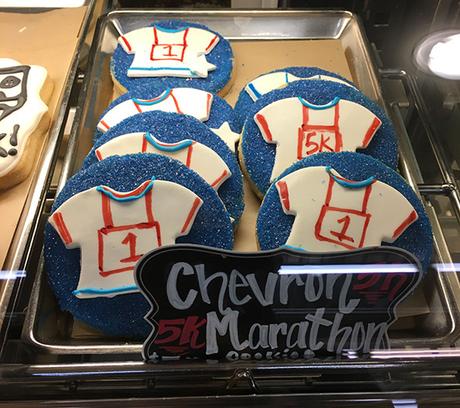
If 2017 were a movie, it may well have been titled “Mother Nature Strikes Back.” And one sad-but-true consequence of nature’s extended wrath was that Americans began to experience “natural disaster fatigue,” for lack of a better term. People wanted to help, but quickly became overwhelmed by the number of worthwhile individuals and organizations asking for their money. So rather than a straightforward appeal to “I run, you donate,” I opted for something a bit different.
I wanted something fun and interesting, but not too gimmicky. And I wanted this to be a legitimate marathon, one in which I’d (literally) be able to put my best foot forward. So no joggling, no running backward, nothing cutesy enough to land me in a Runner’s World newsletter. Then I remembered how, several years earlier, another runner had raised money with a compelling twist: he had been the last runner to start the marathon, and had asked friends and colleagues to pledge based on their estimate for the number of runners he would pass along the 26.2-mile course. The more runners he passed, the more money he raised.
Immediately I loved the idea, in large part because it suited my temperament. Sure, I could run a mediocre marathon and still raise a meaningful amount for the Food Bank. But by running harder and faster I’d raise even more, with the total amount hinging on my own performance. And hopefully my “fundraising with a twist” strategy would get the attention of runners and non-runners alike, who would find the idea offbeat and compelling enough to donate. I was sold.
If I were to do this, it was important to me that I first gain the approval of the Houston Marathon organizers. Thankfully I was able to score an introduction to the Executive Director of the Houston Marathon Committee, who after some back-and-forth signed off on my strategy, with one caveat: coincidentally, the Committee would be featuring its own official “Last Man Starting,” a fellow from Houston with a 2:32 marathon PR who would be running to raise funds for the Houston Marathon Foundation. And so I agreed to replace “Last Man Starting” in my outreach with the phrase “starting at the very back of the pack,” since the latter sounded better than the more honest “First Man Passed.”
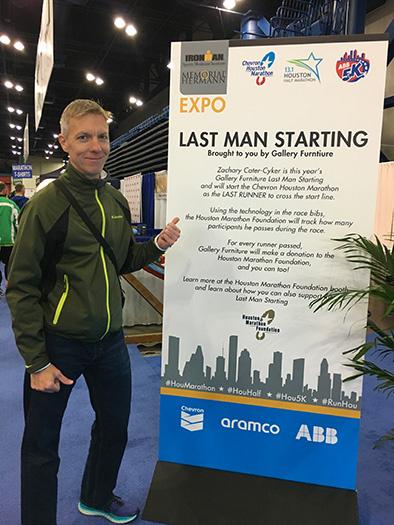
With the logistics worked out, I launched my campaign with an ambitious goal of $5,000. Soon I was fortunate to have my story featured by my alma mater in Rice News as well as by KHOU 11, the CBS affiliate in Houston.
Then I turned my attention to the race itself. And while fundraising turned out to be a laborious and time-consuming process, it would be the tip of the iceberg compared to the training that followed. My determination to give Houston everything I had inspired me to train… and train… and train. Smartly to be sure, keeping my fast runs fast and my slow runs slow, but at a higher intensity than ever before.
Whereas I’d reached 70 miles in a single week on only a handful of occasions before November, for 6 of the last 12 weeks leading up to Houston my training volume exceeded 70 miles. I even topped out at 80 miles to celebrate the last week of the year, three weeks before race day. (Many thanks to speedy running buddy Krishna for sharing his excellent training logs and advice on which I based my own regimen.)
I needed to ensure my legs were ready for the dodge-and-weave, stop-and-start running that awaited them. I still remembered the Walt Disney World Marathon three years earlier, where I’d effectively dashed from one character photo stop to the next. By the time I’d crossed the finish line, my quads were so toasted they practically had smoke rising from them. So I had to be ready to run on tired, heavy legs.
Because I’d never have another shot like this.
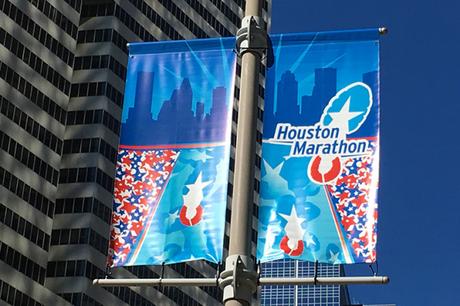
Houston, we have a challenge
A wintry blast of reality greeted our arrival in Houston on a bitterly cold Friday evening. Twelve hours later, motivated in large part by a desire to generate heat and stay warm, Katie notched her personal best at Saturday morning’s ABB 5K. The weekend’s kickoff event was nicely organized and well attended despite the chill, with high energy and closely packed start corrals. I quickly found a small patch of sunlight to warm me as I watched and waited for Katie at the mile 3 marker.
After a celebratory brunch, we headed back to the George R. Brown (GRB) Convention Center (site of the 5K start line) for the easily navigated expo and packet pickup (see “Production” below). Thanks to RaceRaves, we’d been fortunate to be invited on the Houston Marathon Industry Tour, hosted by the Executive Director of the Houston Marathon Committee and joined by several race directors and running industry insiders.
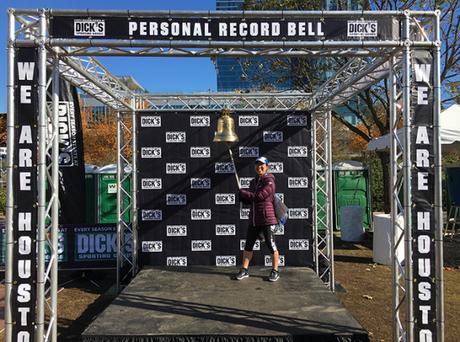
Katie answered the PR bell in the ABB 5K
On the tour we were treated to an eye-opening, behind-the-scenes glimpse into life behind the curtain on race day. We visited the United Command Center (the hub of all race-day communications), media center, medical facilities, check-in/hospitality room for elite athletes, and finally the enormous ground floor of the GRB where — as I’d experience for myself the next day — finishers are directed in a one-way flow from the finish chute at one end of the convention center to the family reunion zone at the other. And I gained a new-found respect and appreciation for the remarkable choreography that goes into producing a world-class event like the Houston Marathon.
As amazing as the tour was, though, the most memorable part of the day was still to come. Because immediately following the tour was the Skechers pre-race party featuring the debut of the new documentary “Meb: The Home Stretch,” which chronicles the final year of Meb Keflezighi’s storied career as America’s greatest marathoner. And Meb himself was in attendance, along with his brother Hawi and fellow Skechers elite athlete Kara Goucher.
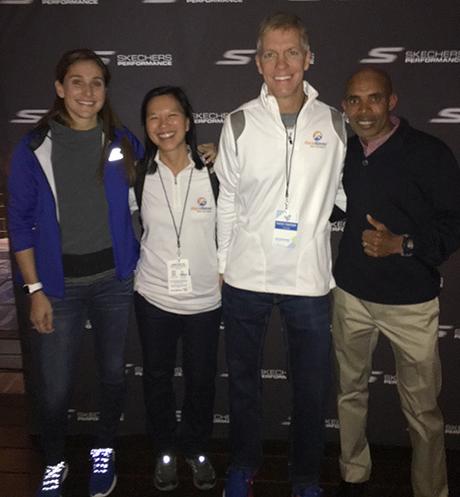
With Kara Goucher and Meb at the Skechers pre-race party
During the Q&A, with no one else raising their hand, I asked Meb about his bold decision to break away from the lead pack during his Boston Marathon victory in 2014, the year after the bombings. And when the moment arrived for a face-to-face with two of running’s biggest stars — well, I could relate to Ralphie in “A Christmas Story” when he finally meets Santa, as I imagined myself staring blankly into Meb’s eyes, nodding my head dumbly and mumbling, “Yeah, football.” I half-expected him to turn to an associate and say, “Ok, get him out of here.”
But as anyone who’s ever met Meb or Kara can attest, both were genial and down-to-earth, and each took the time to chat with every last running geek who lined up to meet them. This was even cooler given that I first started running in Skechers after the 2016 LA Marathon, in large part because of Meb, and have happily worn them ever since.
Sure, in retrospect maybe I did spend too much time on my feet the day before one of the biggest races of my life. On the other hand, maybe our busy Saturday was smart strategery, since that night’s pre-race sleep was one of my best ever at nearly seven hours (!). And I awoke on Sunday morning feeling more relaxed than usual. It helped that our hotel was conveniently located within easy walking distance of the start line. That, together with the fact I’d be starting behind all but one runner, meant I could sleep in until essentially the last minute since I didn’t have to worry about fighting the crowds in the start corrals.
The morning was even colder than predicted (mid 30s) as we made the short walk to join corral “D” queuing outside Minute Maid Park, home of the World Series champion Astros. The first rays of sunrise reflected off the towering glass facades, bathing downtown Houston in a warm orange glow. Unfortunately, that would be the only warmth available as I waited for some sign of forward motion from the densely packed crowds.

If you squint a bit, you can just make out the blue start line arch ahead
There I stood in my Texas flag shorts alongside a bundled-up Katie, waiting and shivering, shivering and waiting — though I didn’t realize the extent of my shivering until I glanced down at my iPhone to see the “You will not receive notifications while driving” warning. I hadn’t been in a car for 36 hours.
Around me, runners dressed like Arctic explorers prepared for a very different marathon experience than my own. Which, in turn, reminded me that this was a very different marathon experience than my previous 29. Typically I’d wiggle my way as close to the front of the corral as possible. Here, though, I waited with growing anticipation as runners like “No Train Dane” (according to his bib) loaded into the corral ahead of me…
… until at last the moment arrived. I ducked into the corral just ahead of the course sweepers with their large, unmistakable balloons. One of them saw the back of my shirt and thanked me for what I was doing. The mass of runners crept forward like a human amoeba as I glanced over at the last line of porta-potties and realized… I’ve gotta go. Delaying the inevitable now would only sabotage my mission later.
Quickly I exited the corral and waited with the last remaining stragglers as the sweepers issued a two-minute warning: “You have one or two minutes, if you’re not ahead of us at the start line your time won’t count!” Nothing motivates quite like fear, and the door to the porta-potty may not even have fallen shut before I’d rejoined the caravan now moving smoothly toward the start. Glancing to my right, I saw a slender fellow smiling on the sidelines and sporting a bright orange “LAST MAN STARTING” singlet. Then the long cold wait was over, and embracing my role as “first man passed,” I crossed the start line 53 minutes and 47 seconds after the gun. The orange singlet would follow 17 seconds later, though I never saw him pass.
The nation’s tenth-largest marathon was underway. And the chase was on.
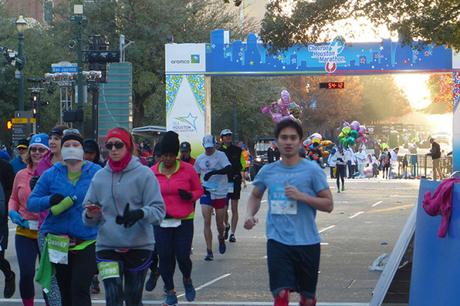
That orange singlet is the marathon’s official “Last Man Starting” crossing the start line
The first 13.1: finding flow
No sooner had I high-fived Katie at the start than my eyes immediately began to scan the scene ahead of me, darting back and forth, looking for openings. Like a running back on the football field I’d see an opening, accelerate slightly to hit the hole quickly, and then zig or zag to avoid the next moving obstacle.
My plan was to target a net finish time of 3 hours, 30 minutes (average pace 8:00/mile) while passing 5,000 marathoners, the latter number being based on our analysis of Houston Marathon finisher results from the past several years. Unfortunately, that same analysis had predicted a more reasonable 37-minute lag time between the opening gun and my own start, so the extra 17 minutes certainly wouldn’t help my cause. And another key variable we’d forgotten to take into account: not only would 7,000+ marathoners be starting ahead of me but also 11,000 half marathoners, many of whom I’d have to pass but none of whom would count toward my fundraising totals.
Whoops.
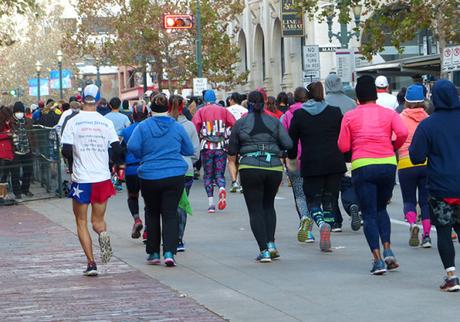
Looks like that guy in the shorts had a wardrobe malfunction
Studies have shown that the optimal race-day temperature for elite marathoners is in the high 30s, with that number rising for slower runners — the faster you run, the more heat you need to dissipate. I’ve run my best finish times in roughly 50-degree temperatures, so Houston’s chill was suboptimal for my SoCal-trained physiology. And it showed, as I could feel my legs taking longer than usual to loosen up and relax.
In the tightly packed spaces of the early miles, a series of on-the-fly decisions informed every step: How much room between me and my next target? How long should I wait before making my move? Can I hit that hole before it closes? Can I squeeze by without getting in anyone else’s way? What’s my margin of error? What is the runner ahead of me — and to my left, and to my right — going to do next? Should I be running on the left or right side of the course? Aid station ahead, veer left!
A key factor in my racing strategy would be to avoid riding the brakes, since doing so decreases the mileage in your legs just as surely as it does the gas mileage of your car. Now, as traffic ebbed and flowed around me, I tried to pick up the pace where possible, only to be confounded by runners who clearly didn’t appreciate their role in my race.
You might think running 26.2 miles is a simple case of crossing the start line and then continuing in a straight line until you reach the finish. But apparently not. I quickly came to realize just how many runners inexplicably drift from side to side when they run, while others would cut in front of me suddenly and without warning, forcing me to make a split-second adjustment to avoid a collision.
Evaluate, anticipate, accelerate, repeat.
One well-meaning friend had suggested it might be “real fun” for me to wear a hurricane costume during the race, as if other runners and spectators would be tickled to see me treating the cause of so much misery with a light-hearted touch. As much as I appreciated the feedback, natural disaster humor is rarely a crowd-pleaser. So instead I superimposed our RaceRaves “running guy” logo on the Texas flag, then shared my motivation on the back of my shirt:
Houston Strong
GOTTA RUN…
The more runners I pass, the more $$$ for the Food Bank!
I figured this would be a better way to communicate my intentions than by appraising every runner as I passed: “YOU’RE worth $2.00! And YOU’RE worth $2.00! And YOU’RE worth $2.00!”
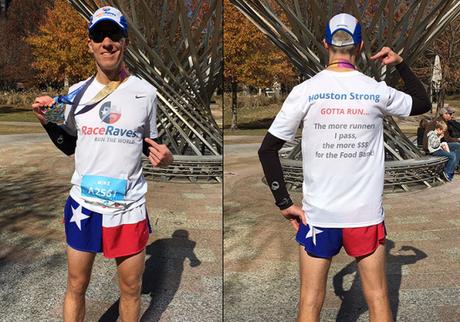
One of the coolest things about the Houston Marathon is its many HOOPLA stations along the course where diverse musical performers and raucous spectators cheer on the runners. By the race’s own estimate more than 250,000 supporters and spectators participate on race day, and certainly the race isn’t lacking for on-course energy.
Passing the HOOPLA station at mile 3.5 where the Houston Food Bank had their table, I paused to high-five their green apple mascot and share a hug with Courtney, who I’d met through my fundraising. Despite being appropriately dressed like an eskimo, she was in high spirits and I appreciated her encouragement.
Given my focus on passing other runners, I spent more time than usual in my own head and failed to take in as many spectator signs as I normally would. The most memorable sign of the day, though, arrived early in mile 2 or 3 and made me smile as it simultaneously acknowledged and poked fun at a sign every marathoner hates: “YOU’RE ALMOST THERE! ISH”.
I viewed most runners in the same way Pac-Man views dots — as nameless, faceless targets to be overtaken without passion or prejudice. But just as Pac-Man has his flashing power pellets to energize him, admittedly I felt a surge of adrenaline as I passed the fellow wearing the jersey of Astros first baseman Yuli Gurriel, who had created a firestorm during the World Series when he made a blatantly racist gesture in the dugout after homering off Los Angeles Dodgers pitcher Yu Darvish.
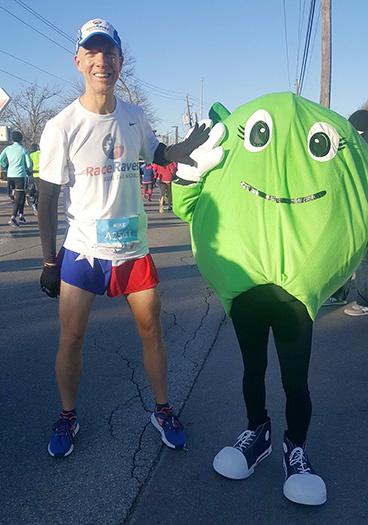
Must be one of them GMO apples! (Houston Food Bank station, mile 3.5)
With the crowds thinning after mile 4, I kept my pace as close as possible to 8:00/mile, which I’d tagged as my optimistic-but-still-realistic goal depending on the extent of my dodging, weaving and braking. I knew dropping the pace too far below 8:00/mile in these early “feel good” miles would come back to haunt me later in the race, with every ounce of energy as precious as a drop of water in the desert.
The course opened up considerably near the end of mile 8, where the marathoners split from the half marathoners. Perfect timing too, as the quiet tree-lined stretch down Rice Blvd past my alma mater was (not surprisingly) my favorite mile of the day. Here an unusually restrained subset of the Marching Owl Band performed for runners, their energetic conductor smiling broadly as we passed.
With its frequently offensive, ill-advised and unapologetic sense of humor, the Marching Owl Band — i.e. the MOB, i.e. “the marching band that NEVER marches!” — is a breath of fresh air in the otherwise pompous world of college athletics. The band’s mocking, devil-may-care attitude toward opposing teams has landed it in hot water on several occasions, most recently in 2016 when it taunted Baylor University for its mishandling of sexual assault allegations. In a conservative state like Texas, the MOB (and Rice in general) stick out like a zebra with spots. And the band’s well-deserved notoriety is a source of great pride among students and alumni.
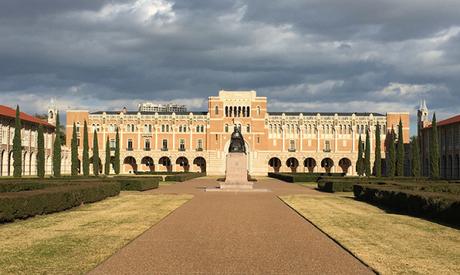
Lovett Hall, Rice University
Aside from Rice, the only landmark I’d remember from my college days would be the House of Pies on Kirby (mile 5), a dessert institution that would live up to all my collegiate memories later that evening after the race. Still the best Boston cream pie in Texas!
With Rice behind us, soon we were back amid strip malls and residential neighborhoods, with screaming spectators seemingly waiting around every turn. Without any other college campuses to smooth its rough edges, much of the remainder of the course would give the (accurate) impression of vast urban sprawl — not unexpected for the nation’s fourth-largest city.
That said, my least favorite section of the course would be the hairpin turnaround at mile 13, on the frontage road alongside US 59. Luckily the least attractive part of the route would be brightened by its most attractive spectator. Katie’s appearance at the midway point was a pleasant surprise, since unlike most races we were never in sync in Houston. I’d later learn this was due to her spending much of the morning directing bewildered Uber drivers, most of whom had no idea a marathon was happening, much less any idea how to circumnavigate the resulting road closures.
And I thought running 26.2 miles was stressful.
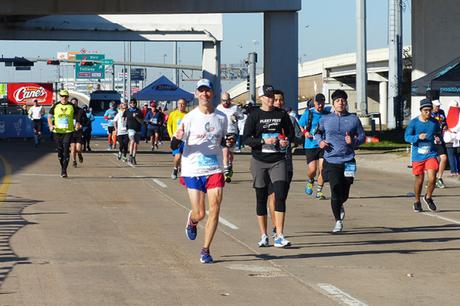
Hankerin’ for 13 more miles
The second 13.1: Pass or fail
As if arriving on cue to start the second half, a chilly headwind hit us in the face as we turned back east on Westpark, the headwind shifting and persisting as we passed the Galleria heading north. More resistance was definitely not what I needed, and I tried to focus instead on my footing — head down, one foot in front of the other — since rough and rutted roads predominated in this construction-rich area.
Several people asked if we noticed evidence of Harvey’s devastation during our time in Houston. The answer is no, not directly, as we didn’t rent a car and so didn’t have a chance to visit the city’s different neighborhoods. But what Katie did notice while hustling from one spectating point to the next was an awful lot of contruction, which we both attributed at least in part to post-Harvey reconstruction.
I didn’t hear a lot of chatter behind me from people reading the back of my shirt, though at one point I did hear a woman’s voice say, “Omigosh, he started at the back and he just passed us!” followed by a chorus of laughter, which made me smile. Much better than GU packets hitting me in the back of my head.
I paused to shake hands with Gary, a fellow I’d met in the Comrades USA Facebook group who’d set up his Runners High table in mile 16. And while there’s still a long hard road ahead in mile 16, the anticipation of counting down the remaining miles into single-digits has always been heartening to me.
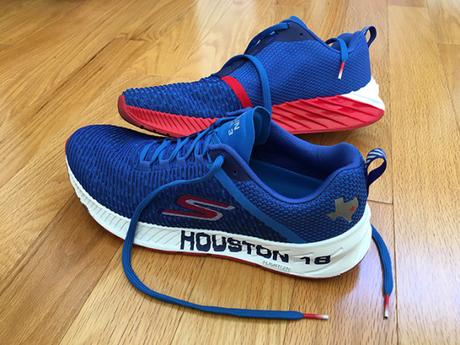
My feet began to ache. When was the last time that had happened during a road marathon? Usually aching feet is a result of running on rugged, technical terrain where every step lands your foot at a different angle. Here, though, I attributed my discomfort to just one thing — concrete.
Most non-runners — and even many runners — don’t realize there’s a significant difference in hardness between asphalt and concrete. Asphalt, or blacktop, is a highly viscous petroleum-based liquid that’s typically used to bind together the elements in “asphalt concrete,” a material used on road surfaces and composed of roughly 95% stone/sand/gravel and 5% concrete. Because of its viscosity, asphalt is much more forgiving on the legs and feet than cement-based concrete, and by extension preferable for running surfaces. The Berlin Marathon, widely considered the flattest and fastest course in the world, points to its asphalt/bitumen surface as one reason the past six marathon world records have been set there.
On the other hand, any kid who’s ever played on blacktop in Texas in July can tell you: asphalt melts in the summer sun, making it much less durable and cost-effective for road construction than its less temperamental counterpart. As a child growing up in the suburbs of Dallas, on occasion I’d discover the summer blacktop sticking to the bottom of my shoe like a wad of chewing gum. Despite my bigger brain and removeable footwear, I could relate to the dinosaurs that wandered into the tar pits only to get inextricably stuck.
So unlike cooler weather states like, well, nearly all of ‘em, most roads and highways in Texas are surfaced with heavy-duty, long-lasting concrete. Which is great for increasing the lifespan of the road, though not so much the lifespan of your legs as a runner. And the fact is, the human body hasn’t evolved to run on concrete so it lacks well-honed adaptation mechanisms.
The upshot? Concrete is Kryptonite for the most well-trained legs and feet.
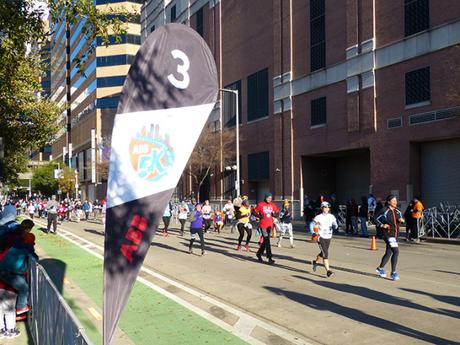
We interrupt this long-winded marathon to admire Katie’s 5K finishing form
My “head-scratcher of the day” award goes to the announcement broadcast over the PA system in mile 20 that “Registration for the 2019 Chevron Houston Marathon and Aramco Half Marathon opens this afternoon at 3 pm!” The moment was so surreal, so absurd, I couldn’t help but smile. Or maybe the message was intended as comic relief? Either way, my quads were unimpressed… not a real keen sense of humor in those boys.
Passing the vast, browned-out expanse of Memorial Park, my distracted brain wrestled with the reality that this entire area had once been underwater after Harvey. The notion was tough to fathom given that the scene now looked so… normal.
My final Katie sighting came just inside the inflatable red CLIF arch in mile 22. There I paused for a few high knee lifts, hoping to loosen and revive my legs for the last few miles. My quads were having none of it. The CLIF Energy Zone turned out to be a loud and lengthy stretch of music I barely noticed, though I do mark it as the point at which the wheels started to — if not fall off, then at least wobble noticeably. Ah, the nostalgia of the marathon…
The final four miles became a deeply focused exercise in “Next runner standing.” Like a video game, I’d set my crosshairs on the closest runner or group of runners, channel all my energy into passing them, then quickly refocus on the next runner. The aching in my feet was supplanted by the heaviness in my quads, which slowly but surely were adopting the rigidity of the concrete beneath them.
This is it, I thought — the moment I’d trained for, the reason for the two-a-days and the motivation behind the 70+ mile weeks. And though I’d continue to leak oil as my mile times crept above 9:00, the truth is I could’ve hit The Wall much harder. All the high-mileage training weeks would pay off mentally and physically, as I refused to stop moving despite the increasing difficulty of lifting each leg.
Evaluate, anticipate, accelerate, repeat.
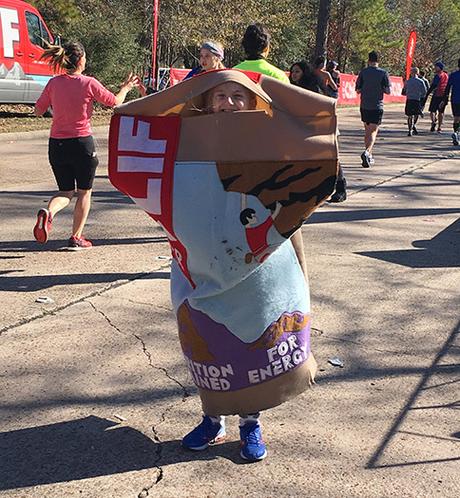
Glad I wasn’t the only one seeing dancing CLIF Bars on the course
Adjusting my stride to take shorter, quicker steps, I kept my attention focused on the runner immediately ahead of me as my surroundings faded into the background. NASA (or SpaceX) could have launched a rocket on the side of the road and I barely would have noticed.
Mile 23, and a reminder over the PA that registration for the 2019 race opens at 3 pm. Like a boxer taking a standing eight count, the voice sounds very far away. Three miles ahead, Molly Huddle is celebrating her new American half marathon record despite finishing 7th overall. I’ve now run in the same races where the American women’s half marathon record and the current marathon world record (Berlin 2014) were set. That can’t be coincidence, right?
Looking at my splits and the elevation gain/loss per mile this sounds ridiculous, but miles 24 and 25 included several small but significant hills (i.e. highway overpasses) that I actually appreciated for the opportunity to engage different muscle groups. And the corresponding downhills couldn’t have come at a better time.
I recalled an email exchange with Krishna in which he’d referenced studies showing that the major cause of marathoners slowing down in the latter stages of the race isn’t hydration or nutrition, but rather muscle breakdown. Much of my own experience jibes with this conclusion, and once again here I was falling victim to the cold, cruel reality of muscle breakdown. Because as physically hammered as my legs were, I felt remarkably good from the waist up.
I don’t sweat much even under normal conditions, and since the Comrades Marathon last year I’ve taken to training in a depleted state. So on a cold day in Houston I ended up using not a single aid station — no water, no Gatorade, no nutrition, no need for it. At one point I thought about eating one of the three GUs I was carrying, but the idea never sounded appealing and I didn’t want to risk sabotaging my efforts by throwing my stomach a curve ball.
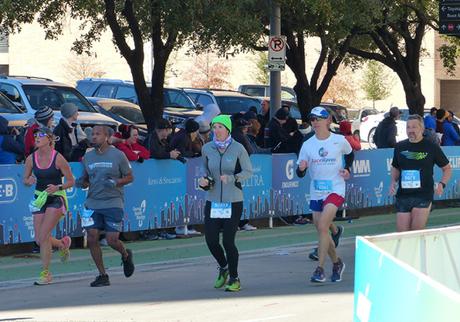
Closing the gap on the last few runners in the home stretch
One eternal truth about the marathon: whether you’re running a 6:00 or 10:00 mile, if you’re able to keep running in the last 6 miles you’ll pass a lot of people. And so I did, as runners turned to walkers and walkers stopped to stretch their cramping legs on the side of the road. What my pace was, I had no idea and frankly it didn’t matter — I was doing everything in my power to keep running, despite my leaden legs pleading with me to call it quits and walk it in from here. Let’s walk just a few steps, it’ll feel sooooo good.
I remembered the image of Meb collapsing in exhaustion at the finish line of his final New York City Marathon in November and thought to myself, My legs are going to have to give way beneath me; otherwise we’re going to keep moving and finish this thing, Houston Strong. There’s no other way.
Corny though it may sound, the thought of disappointing a single donor or missing out on a single meal for the Food Bank pained me far more than the heaviness in my quads. Physical discomfort would fade with time; disappointment would not.
High-fives to the awesome spectator who called out “FINAL TURN!” as we veered onto Lamar for the home stretch. As appreciative as I was, though, I couldn’t yet see the finish line ahead and had no clue just how long this final straightaway would last, since I wasn’t sure how much bonus mileage I’d accrued with all my dodging and weaving.
I glanced down as my Garmin beeped for the 26th and final time: 9:23, yikes. Given the effort I was exerting with each step, I’d felt sure I was moving at Road Runner speeds. Turns out it was more like Wile E. Coyote. I exhaled and glanced up feebly to see — no sign of the finish line ahead. Damn.
Head down, keep going, keep passing, hear the cheers, this is it, stay strong, stay focused, trust you’re almost there, pass him, pass her, catch him catch him catch him, empty the tank, YEE-HAW YOU GOT THIS PAHD’NAH!
And then, in one indescribable moment of sheer pride, 16 weeks of my life came to fruition in the form of a brilliant blue finish arch, which welcomed me home in a gun time of 4:35:43 and chip time of 3:41:56, a nearly 54-minute differential. Happily, the wheels hadn’t completely fallen off the wagon in the second half. Certainly my splits — 1:49:21 in the first half, 1:52:35 in the second — earned me my 29th positive split in 30 marathons. But given that I’d started so far behind the eight ball, this may well have been the most positive split of them all.

Try telling my quads that’s “accomplishment” they’re feeling
Mission accomplished
As it turns out, I’d had greater success running from the back than the official “Last Man Starting,” who ended up crossing the finish in a chip time of 3:22:20, some 50 minutes off his personal record. Meanwhile, my own finish time fell within 20 minutes of my PR from the 2015 Mountains 2 Beach Marathon.
Pausing to ensure my legs were still under me, I turned to watch a few more runners follow me across the finish mat. And I stood for a moment, basking in the realization that each and every finisher for the next 2+ hours would be someone I’d passed along the course.
Then, barely registering the cold on my skin, I took my time strolling through the finish chute, gratefully collected one of my proudest finisher medals to date and mindlessly followed the flow of weary runners into the George R. Brown. As outlined on Saturday’s Industry Tour, the GRB was smartly set up to provide all finishers with a place to warm up and chow down before reuniting with friends and family (see “Production” below). There I collected more finisher’s swag and grabbed a quick bite at the HEB breakfast station, before Katie and I retraced our steps to the finish line to cheer across the last few finishers — even the fellow in the Gurriel jersey.
The Boston cream pie at House of Pies never tasted better than it did that night.
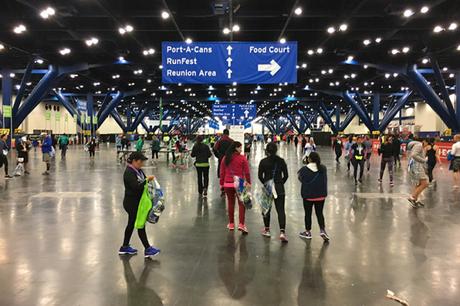
Post-race in the not-so-notorious GRB
For the next two days, on the heels of my successful come-from-behind effort, I’d be walking… on my heels. Quad extension would be challenging at best, and if you hadn’t known better you would’ve guessed this was my first 26.2-mile rodeo. My lack of mobility turned almost comical on Tuesday as freezing rain coated the streets with ice, turning even the shortest walk into a slow-footed shufflefest. Icy curbs might as well have been the Berlin Wall.
But every microscopic muscle tear would be worth the discomfort. Because when the dust settled, I’d officially passed 3,820 of 7,000 finishers, not counting the 11,000 half marathoners who’d started at the same time. And thanks to all the amazing friends, family and colleagues who answered the bell, we eclipsed our already ambitious goal by raising $8,400.56 = 25,201 meals for the Houston Food Bank and the victims of Hurricane Harvey. I’m proud to say that’s more dollars than even words in this blog post. And I can’t thank my donors enough for their heroic empathy and selflessness.
Don’t mess with Texas, indeed.
Katie and I extended our Houston stay so we could visit the Rice campus on Monday (MLK Jr. Day) and volunteer at the Food Bank on Tuesday. Mother Nature, though, would have other ideas, as the aforementioned freezing rain ended up canceling both our volunteer shift at the Food Bank and our return flight to SoCal. So we had no choice but to “stay a spell” and enjoy Houston’s hospitality for one more night, as the city hunkered down under a rare winter storm warning.
Our snowed-in situation brought to mind a verse from my childhood, memorable for both its unapologetic grammar and its unabashed sentiment, and most likely learned from a bumper sticker years before the birth of the Internet:
The sun has ris, the sun has set,
and here I is in Texas yet.
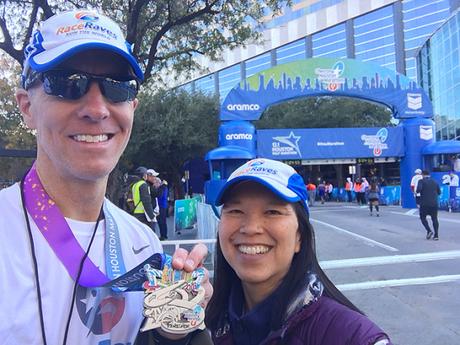
The Houston Food Bank, a top-rated 501(c)(3) charity on CharityNavigator.com, is able to stretch every $1.00 donation to provide one person with a full day of meals. Please support their continuing hurricane relief efforts to help rebuild lives and keep the Bayou City #HoustonStrong!
BOTTOM LINE: Recommending the Houston Marathon is as easy as sliding off a greasy log backward. Houston is a crown jewel of the US marathon circuit, being one of the more smartly planned, flawlessly organized and professionally executed marathons you’ll ever have the pleasure of running. With 7,000 marathon finishers and over 11,000 half marathon finishers this year, it’s the tenth-largest marathon in the country. And yet everything flows so smoothly throughout the weekend, from the pre-race expo to the post-race exit from the George R. Brown Convention Center, that you almost won’t mind being herded like cattle into the crowded start corrals on race morning — and especially if race day temperatures hover around freezing like they did this year.
The race itself was a high-energy tour of the nation’s fourth-largest city, with an untold number of HOOPLA (cheer) stations set up along the course, along with a diverse array of musical performers to keep you constantly entertained and keep your mind distracted from the fact you’re running 26.2 miles on one of the hardest surfaces on the planet. The course is largely flat and speedy, though several wickedly positioned uphill jags in the final four miles will look to sap whatever life remains in your concrete-stricken legs. And once you cross the finish and collect your well-deserved medal, actual breakfast food awaits inside the George R. Brown (see “Production” below). Apologies to all you diehard fans of green bananas and stale bagels.
I ran this race differently than I had any of my other 29 marathons, starting from the very back (nearly 54 minutes after the gun) and passing runners to raise money for the Houston Food Bank’s Harvey relief efforts. So my focus throughout the race was less on enjoying myself (though I definitely did) and more on amassing “roadkill” (to use the Ragnar term for runners passed). That said, this struck me as an ideal marathon (or half) for first-timers, with so many raucous spectators and supporters — 250,000, according to the race website — to keep propelling you forward when the Gatorade and energy gels no longer can.
As a mobile supporter who likes to spectate at several points along the course, Katie had a tougher time in Houston than at most other races. Luckily the race provides a handy business card-sized Spectator Guide that folds out like an accordion, so figuring out where you want to see your runner on the course is easy enough. Getting there, on the other hand, can be a logistical nightmare. Katie spent much of the morning directing Lyft or Uber drivers who either didn’t realize the marathon was happening or didn’t know how to circumnavigate road closures to reach her destination. As it turns out, having her own vehicle would have made the morning more manageable and less stressful — something to keep in mind if you’re planning to be a mobile spectator yourself.
Disclaimer: I grew up in Texas and graduated from Rice University, so I already had a strong personal connection to the city. Even objectively, though, Houston is a must-run event for the hardcore marathoner or half marathoner based on the three E’s: efficiency, energy and all-around excellence. In the wake of Hurricane Harvey, the city’s unity and pride were on full (and vociferous) display throughout the weekend, and I’m psyched to have played a small role in helping a world-class city get its groove back.
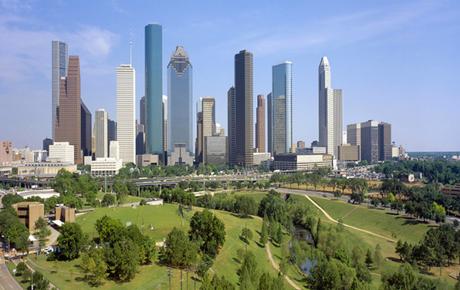
(photo: imperialsugarland.com)
PRODUCTION: In the best situation, producing a 20,000+ person event in a major urban center is a significant challenge. Throw in one of the most devastating natural disasters in U.S. history, and you add a level of complexity and uncertainty to the mix that would cripple most race organizations. And yet the Houston Marathon team managed the unforeseen arrival of Hurricane Harvey like the experts they are. And any arguments I might have with the production are more suggestions than gripes.
The 2018 Race Program provided a wealth of interesting and relevant information about race weekend, the runners and the city itself. And honestly I read more of the program in Houston than I did in either Boston or New York. Flooding apparently moved this year’s expo to a smaller hall than previous years within the George R. Brown Convention Center (GRB); however, packet pickup was quick and easy, and the expo itself was very manageable and easily navigated within an hour, even with several stops at sponsor booths (gotta check out all the races!).
I stopped at exactly zero aid stations on the course, but I did notice water and Gatorade were provided in different-colored cups (water in plain Dixie cups, Gatorade in branded cups). As trivial as this may sound, visually differentiating the two helps to alleviate in-race confusion, particularly for the tired runner, and it’s one of my litmus tests for whether a race organizer knows their stuff. Because many don’t.
Immediately after the race, finishers were funneled into the GRB. There we collected more swag (see below), enjoyed a McMuffin-style breakfast and ice cream sandwich plus hot and cold drinks while chatting with fellow finishers, and finally reunited with friends and family to wander the “We Are Houston” RunFest set up on the Discovery Green outside the convention center. In my experience this smartly conceived, one-way directionality of post-race traffic flow (exit –> swag pickup –> breakfast –> gear check –> family reunion) on such a massive scale is unique to Houston. And while it arguably makes life more difficult for family members who have to wait at one end of the hall for their runner to reach them, it’s easy to see how creating this “finishers only” space would benefit the runners by reducing both traffic and confusion, particularly in the dining area. Though I can’t imagine this setup is optimal for sponsors who are (literally) left out in the cold in their tents on Discovery Green — aside from HEB which provided breakfast, Skechers was the only sponsor I noticed with presence inside the GRB.
And speaking of Skechers, all official Houston Marathon apparel and merchandise is 50% off at the Skechers booth on race day. So if you’re willing to wait and gamble that your size will still be in stock come Sunday, you can score some pretty sweet deals on everything from water bottles to shoes. I actually train in Skechers and ran the marathon in the Skechers GoRun Ride 6, so I can vouch for the fact the company makes a very comfy running shoe.
The GRB opens on 5:00am on race day to accommodate early-arriving runners, a nice convenience and especially in bone-chilling cold like we had this year. Coming from out of town, we stayed in the downtown area (at the Aloft Houston Downtown) within walking distance of the start line, and so were able to wake up later than most and arrive after the starter’s pistol had already fired. I’m pretty sure that not having an insanely early wakeup call helped me relax and enjoy one of my best pre-race night’s sleep in recent memory.
My only real suggestion for the organizers would be to move the celebratory photo-op signage (“Feel the pride,” “Feel the accomplishment” etc) from the finish chute just inside the GRB — where many dazed and exhausted runners passed them by without so much as a glance — to the family reunion area where they’re much more likely to be appreciated. Oh, and I’d recommend rethinking the on-course announcement at miles 20 and 23 that “Registration for the 2019 Chevron Houston Marathon and Aramco Half Marathon opens this afternoon at 3:00pm!” The timing was so absurd that even in my depleted state, I couldn’t help but laugh in the moment. Or maybe that was the point?
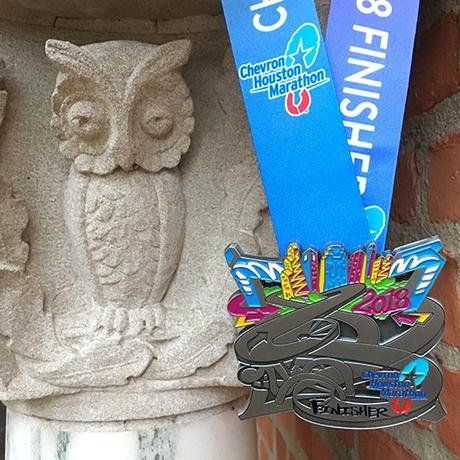
SWAG: The finisher’s medal is entirely unique and distinctly unTexan, being the creation of local aerosol/graffiti artist Mario E. Figueroa, Jr. aka Gonzo247. And though I wouldn’t have been upset with something in the shape of Texas, as a lover of street art this is a standout addition to my collection. Beyond the medal, runners received not one but two shirts — a Gildan short-sleeve cotton tee at registration with “Run Houston Strong” printed on front and a Skechers short-sleeve performance finisher’s tee after the race, which like the medal features Gonzo’s artwork above the word “FINISHER.” But wait, there’s more! Unfortunately, that “more” came in the form of a glass finisher’s mug that I will never use and which will sit on my shelf at home gathering dust for all eternity.
Updated 50 States Map:
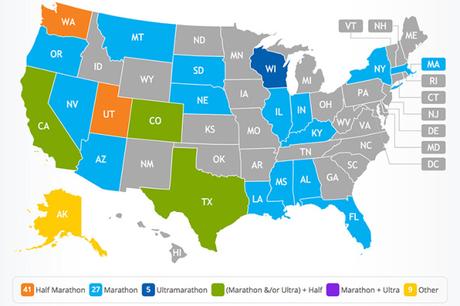
RaceRaves rating:
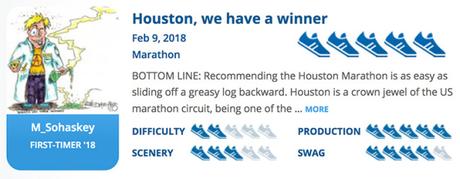
FINAL STATS:
Jan 14, 2018 (start time 7:00am)
26.57 miles in Houston, TX (state 19 of 50)
Finish time & pace: 3:41:56 (first time running the Houston Marathon), 8:21/mile
Finish place: 1,325 overall, 131/614 in M 45-49 age group
Number of finishers: 7,001 (4,319 men, 2,682 women)
Splits: 1:49:21 (first half), 1:52:35 (second half)
Number of marathoners passed: 3,820
Race weather: cold & sunny at the start (35°F) and finish (46°F), breezy throughout
Elevation change (Garmin Connect): 147 ft ascent, 141 ft descent
Elevation min, max: 11 ft, 73 ft
Dollars raised for the Houston Food Bank: $8,400.56 (= 25,201 meals)
